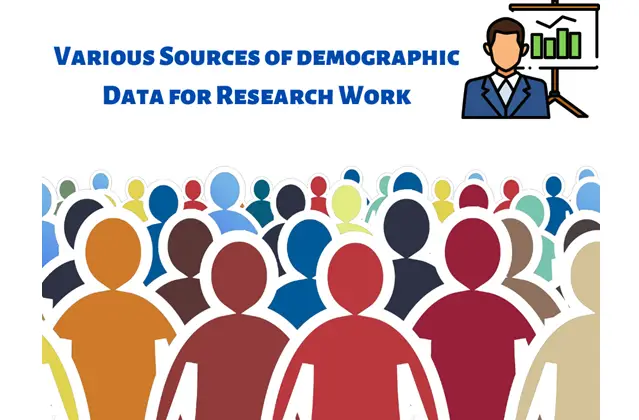What is demographic data?
Demographic data refers to the collection of statistical data which is collected concerning the population, gender, age, and income. Usually, the demographic data is collected through means of samples, surveys, and questionnaires. The demographic data is researched by considering a product or service, reading how it is sold, or what its preference ratio is. There are a lot of predictable things when it comes to demographic data, but certain things can only be ensured when exact data is provided in the form of statistics.

Research has been an essential part of education, and it is believed that a person who can research well can get prompt knowledge. In the motion of the saying demographic data has been a significant part of the government corporations, non-government organisations, businesses, health, social care, nursing and student help organisations having assignment help experts, etc. There are several fields in which demographic data plays an essential role because of the benefits it provides to the researchers like:
Understanding characteristics, background, and audiences very well.
- Evaluating the needs and wants of different sectors of customers and their affordability.
- Helps in nursing and health care to create better relations with the patients and personalise interactions for effective treatment.
- It helps in marketing as it becomes much easier for businesses to demographically market their product based on the age, income, gender, and education of a particular sector of customers.
- It helps identify the key demographics for the business purposes like the geographical location, education level, marital status, household income, hobbies, and occupation.
The demographic data is mainly used to group the customers based on their gender and age. This allows every type of business to understand the segment of selling and the requirement of the customers based on the variables mentioned above. This data can be used to analyse the growth of the business as they understand how well the customers like their products and what all limits the customers can cross to buy the business’s product. There are times when businesses make mistakes that lead them to significant issues later; demographic data helps save these people from making mistakes.
Demographic data helps businesses to customise their products according to different consumer groups. Every business sells a different set of products and services, which can be arranged better when they have an approximate idea of what the customers’ overall requirements are and what they need to keep available with them to do well in the market. Different customer groups have different footfalls and requirements; demographic data helps the business have an approximate idea of the requirements for business growth.
Various sources of researching demographic data
Demographic data is used in many vital areas, which is why it needs to be accurate and effective. There are many ways in which the research can be accomplished effectively, but some of the most appropriate sources of researching demographic data are:
1. Civil registrations system
The registration system is believed to be one of the most important data collection methods. Various events like birth, death, marriage, divorce, etc., are considered requisite accounts of every citizen of the country. When either of the events takes place, it must be registered at the respective authoritative office, which makes it easier to analyse the demographics.

Source: https://www.pexels.com/search/office%20building/
Another important secondary source for research is population data collection. Many countries also follow and maintain a permanent population register for various legal purposes. It includes all the crucial details of the citizens like the age, gender, address, migrants, etc. The register also helps maintain accurate data of the activity in a country.
Except for this, there are also international publications that include sources from various countries, specifically the United Nations demographic year and statistical yearbook. This is a monthly journal launched by the world health organisation for managing vital records that give data on the public ephemerality and different countries. Even the United Nations development programme (UNDP) is a human development report that the world bank publishes annually to evaluate all types of demographic data relating to projections, fertility, mortality, health, and population growth.
2. Population census
The population census is the most important and popular source of searching demographic data. Census has been derived from a Latin word meaning “to assess”. Some of the critical functions of the census which make it essential and the most popular are:
- Census is completed in a specified period.
- Usually, the census covers the entire country.
- A census is conducted and performed every ten years.
- The census finally filled up is collected, analysed statistically, and examined by the census commission to evaluate the accuracy and correctness of the data before launching.
- The census data is continuously published for circulation and speculations (if any).
The census helps the most in keeping track of the demographic data by:
- Providing data of the primary population regarding age, gender, economic activities, martial status, migration, and occupation.
- Census is actively used in making population projections.
- There are many sample surveys which evidently require the census for application.
- Census also throws light on the problems like socio-economic issues like population density, literacy level, male-female sex ratio, women’s status, urbanisation, and literacy level.
Census is a great option and source of collecting demographic data, but it may not always be the best in all cases as the census operations are very costly in terms of money, men and materials. It requires enormous manpower, tons of paper forms and a lot of money for processing, preparation and publishing. There are many other issues with the census like the enumerators may or may not collect accurate data; they may mistakenly input the wrong data, and some even may be disloyal to their work and enter fake or dishonest data in the forms. Several other reasons restrict the census data from being appropriate and up to the mark, which is why it may not always be the best way to perform the research.
3. Sample surveys
A sample survey is yet another effective source of collecting population data. Information in a sample survey is collected through individual samples rather than the population as a whole. Sample, as the name itself suggests, is a fraction of the overall available population. From each sector of the population, a particular sample is picked up based on which the conclusions are drawn. One of the most common examples of survey samples includes the number of vehicles purchased and sold in the case of the study of automobiles. A sample survey is one of the least time and money-consuming techniques of demographic data selection. It is used to supplement the census data and to carry out future trends in population growth amongst the census operations. Usually, the sampling is used to check the accuracy of the census data if any doubt arises in the census results.

Source: https://www.pexels.com/search/survey/
Some countries perform a national survey based on the stratified random sampling and sampling method. The survey sample demands a small set of trained staff along with small questionaries relating to an aspect of the population. The data collected through the sample survey is analysed, tabulated, and published.
Sample surveys are an excellent option for performing demographic research, but it also has some limitations like:
- It demands surveyors who are proficient with the work. In case even if a single surveyor is not able to accomplish the tasks effectively, it may impact the overall survey at once.
- The sample survey is done through the samples. If the samples are non-cooperative and do not respond accurately, the research may be left unattended and inappropriate. The results gained from this survey may not lead to exemplary results.
- There is a huge possibility of errors in the overall classification, coverage, and sampling of the data of the population.
- There may be instances where the surveyor’s research at different data sets with different samples of the same population.
Conclusion
Demographic data is data one of the essential characteristics of the population. This includes age, gender, and income as well. It is used in nearly all the fields of a country for estimating their customers and their characteristics. The prevalent research methods like civil registration systems, census, and sample surveys are some of the most common and popular research techniques. Each of these has many advantages and disadvantages, like in the civil registration system; the data may not be updated timely, leading to wrong evaluation.
In the census method of research, the surveyors are supposed to reach door to door, which is highly time-consuming and monotonous, leading them to act disloyal and not provide truthful information to their superiors. In the sample survey method, the chosen samples may be inappropriate and not lead the surveyors to the best results. Seeing the importance and need of accurate demographic data, a lot of newer research methods are being launched, which can reduce the hard work of the organisations and ease the process with less or no involvement of humans and other expensive sources.
Also Read: